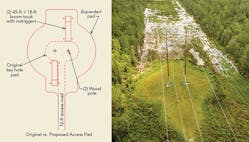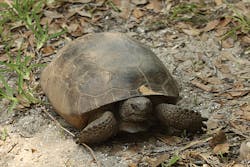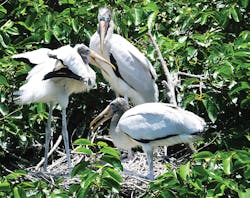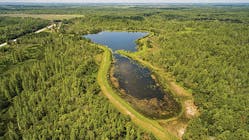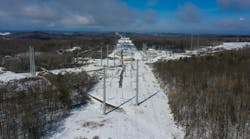It is not uncommon for a power line upgrade project to require innovative engineering. It also is not unusual for such a project to involve complex permitting issues. But throw in a large amount of civil and environmental engineering, permitting and construction work, along with the management of numerous subcontractors over a six-year construction schedule — all while working with a live line — and one can understand the degree of difficulty the Orlando Utilities Commission (OUC) was facing when it engaged Black & Veatch (B&V) to engineer and manage the upgrade of its 46-mile (74-km) Orlando-Lakeland transmission line.
The original 230-kV Taft-Lakeland transmission line began operating in 1981. At the time, it carried OUC’s share of Lakeland McIntosh Unit 3’s output (134 MW) to the utility’s Taft substation south of Orlando, Florida, U.S. Since then, the population of Greater Orlando has nearly tripled to about 2.1 million, while the Lakeland area population has almost doubled to about 623,000, causing a considerable increase in demand for electricity.
Working together, OUC and Black & Veatch divided the complex project into four distinct phases with a construction schedule spanning six years. The project team would have to deal with more than economic and technical issues. Environmental permitting would be just as important since the Taft-Lakeland line passes through one of the most ecologically sensitive areas of the state. The region includes pastureland, citrus groves and sensitive swampland, most of which is within the 50,000-acre (20,234-hectare) Green Swamp Wildlife Management Area the state of Florida has designated as an area of critical concern.
New Rules, New Issues
The transmission line was originally certified by the state of Florida under the Power Plant Siting Act, therefore, all line modifications and construction impacts had to be submitted for approval to numerous state and federal agencies. This led to numerous lengthy — and often unexpected — permit applications
From the outset, the project team — advised by environmental consultant Golder Associates — was in constant communication with a range of federal, state and local regulatory bodies: U.S. Army Corps of Engineers, U.S. Fish & Wildlife Service (FWS), Florida Department of Environmental Protection, Florida Fish and Wildlife Conservation Commission, Hilochee Wildlife Management Area, Polk County, Orange County, Osceola County and the Reedy Creek Improvement District, a governmental body created in 1967 to oversee development by the Disney companies.
OUC built the Taft-Lakeland line 35 years ago under construction restrictions that minimized its impact on wetlands. These restrictions resulted in narrow roads and small working pads around line structures, neither of which would make access possible during the rebuild construction, let alone accommodate the live-line maintenance equipment necessary to keep the upgraded line operating year-round.
New live-line maintenance rules mandated wider access pads at several structures as well as wider and, in some cases, elevated access roads to facilitate the use of OUC’s new, larger hydraulic bucket trucks. These trucks, both safer and more efficient than older models, give maintenance crews a level of flexibility and safety during live-line work not previously available. Clearly, the team not only was facing an extraordinary amount of civil engineering work for a transmission line upgrade of this type but also additional environmental permitting complications. Even so, there were more surprises ahead.
The Tortoise and the Corps
The U.S. Army Corps of Engineers and the Florida Department of Environmental Protection authorized a total of approximately 23.3 acres (9.4 hectares) of wetland fill and 1.66 acres (0.67 hectares) of forested wetland clearing for the necessary road and pad expansions. However, to mitigate that impact, the agencies required OUC to provide a total of 17.5 credits of compensatory wetland mitigation from four different mitigation banks within different drainage basins. This translated to 88,504 cubic yards (67,666 cubic m) of floodplain compensation and the creation of 5.4 acres (2.2 hectares) of freshwater marsh and emergent aquatic vegetation adjacent to an existing man-made pond within a state wildlife management area.
But that was not all. Because the rebuild was taking place in Florida, the project team expected construction to involve two things: wetland mitigation and the resettlement of tortoises from the high and dry areas along the right-of-way. However, a new regulatory wrinkle blindsided the team.
Wood Stork Forage
When the project team filed the initial U.S. Army Corps of Engineers permit application, the Corps notified all other concerned agencies, including the FWS. As it turned out, the FWS had new blanket rules protecting core foraging areas for colonies of wood storks. If a project is determined to impact a stork foraging area, the developer must take steps to avoid or minimize that impact. Failing that, the developer must offset those impacts with a wetland mitigation plan that provides new wood stork foraging areas.
After performing additional studies, Golder determined, while the transmission line expansion would affect several wood stork foraging areas along its length, OUC’s wetland mitigation efforts would serve a dual purpose by also providing the required additional foraging area.
Beware the Sand Skinks
As it turned out, wood storks were not the only wildlife challenge to confront the project team. Next up were blue-tail skinks and sand skinks, small lizards indigenous to Florida that primarily live underground in sandy locations. During the permitting process, the FWS offered the project team a pair of options: either survey for actual skink habitat along the right-of-way or purchase two credits per acre of potential skink habitat for the entire project. Because skink credits sell for about $30,000 each, these little creatures would have run up a very large bill.
If the team decided to survey for an actual skink habitat, it would have to use FWS’s new protocol for identifying skink habitat, which could only be applied in springtime. Fortunately for the project team, it was springtime when the issue arose, minimizing what could have been a disastrous project delay. Capitalizing on its luck, the team determined the best approach was to do the survey but limit it to the areas the project directly affected — the access roads and pads, not the entire right-of-way. The agency agreed. This limited the final survey area to just 12.69 acres (5.14 hectares) of potential skink habitat, which still represented a potential skink credit cost of almost $750,000.
In the end, the new survey protocol required Golder to place almost 500 2-ft by 3-ft (0.6-m by 0.9-m) plywood cover boards on cleared ground along the affected areas and check under them for skink tracks every week for a month. This labor-intensive process revealed skinks living on just 0.85 acres (0.34 hectares) along the transmission line, and OUC purchased the required 1.7 credits from a local skink bank at a cost of $50,150. While the project suffered a minor delay, it was not nearly as long as it could have been had this situation occurred during any other time of the year.
Getting Creative
One section of the Taft-Lakeland line passes through the Hilochee Wildlife Management Area, 9000 acres (3642 hectares) of protected land in both Lake and Polk counties. Although the team initially thought that upgrading an existing line would result in minimal disturbance to land within that wildlife management area, state officials thought otherwise and insisted OUC secure authorization from the Florida Department of Environmental Protection.
In turn, this meant the project team was required to go before the state Acquisition and Restoration Council, which reviews all management plans for state lands and has its own set of requirements. In addition to requiring developers to prove their projects will cause no harm, the council mandates the developers also demonstrate their work will provide a positive net environmental benefit.
Accordingly, the team began examining detailed maps of the area and discovered an old borrow pit that provided fish and wildlife habitat. However, it certainly was not built the way Mother Nature would have done it. Large spoil piles surrounded the pit, the shoreline had steep slopes and the lack of a vegetated littoral zone meant it offered little benefit to wildlife. As a remedy, the team redesigned the pit to make it more natural in appearance and better suited for wildlife. Enhancements began with the cleanup, removal and disposal of the large stockpiles of dirt that were left when the pond was built.
With the piles removed, the project team was able to modify the slopes to create shallow vegetated littoral zones around the pit as well as new wetlands to the northeast. This not only expanded fish and wading bird habitat, it also enhanced public recreation opportunities, thus increasing the value of the pond to the state. With OUC absorbing all costs — without claiming any mitigation credits — the transmission line work gained unanimous approval.
Clearly, environmental permitting could have been a major issue on this project, but it was not because OUC was able to keep it simple and manage the complexity without making things more complicated than necessary.
Charles H. Easterling is manager of transmission construction and system maintenance at Orlando Utilities Commission, where he has worked for 25 years. Easterling earned a bachelor’s degree in electrical engineering from Georgia Institute of Technology in 1991 and has been a registered professional engineer since 1999.
Hrishikesh P. Moghe is a project manager in the Houston, Texas, office of Black & Veatch, where he oversees power-delivery projects. Moghe holds a BSCE degree from Mumbai University and a MSCE degree from Louisiana Tech University. He is a registered professional engineer.
Editor’s note: "Complexity of Powering Central Florida’s Future," published in the July issue focused on the line design and construction aspects of this project.
An HOA Point of View
It is not uncommon for the scope of a project like the Orlando Utilities Commission’s 46-mile (74-km) Orlando-Lakeland transmission upgrade to encroach on human as well as aquatic and woodland habitat, requiring constant communication with the transmission line’s neighbors. To illustrate the success of the project team’s outreach efforts, it is probably best to quote a resident in an article from the May 2009 issue of Life at Hunter’s Creek magazine, a publication of the Hunter’s Creek Community Association, a 4000-acre (1619-hectare) planned community near Kissimmee, Florida, U.S.:
“OUC is under a direct mandate from the federal government to make upgrades to this very important power line system. I had reviewed the plans and had meetings with OUC management prior to the start of this work, but I would not be completely honest if I did not mention that when I first saw the many trucks arrive on site near Keaton’s Crest at the start of this operation, I was very concerned and, if my memory serves me right, quite outspoken,” said Roy Figg, Hunter’s Creek manager of maintenance and landscape. “Now, at the near completion of this operation, all I can say is, ‘Good job.’ OUC has never failed to maintain regular contact with me directly or through their managing consulting firm, Black & Veatch, which updated me with regard to the progress of this operation and how it may or may not directly impact Hunter’s Creek.”

